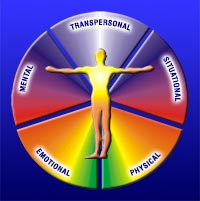 |
| The Violence Integrative Prevention and Restoration (PAR) Model incorporates the "Five Bodies" model — a concept used throughout the International Center's compassion initiatives. |
| |
PUBLICATIONS
AVAILABLE |
Three White Papers and an information sheet referencing the PAR Model are available at no charge for viewing, downloading, and distributing:
|
| |
| |
| |
The Violence Integrative Prevention and Restoration Model is a copyrighted intellectual property of Pax Cascadia, LLC and is licensed to the International Center for Compassionate Organizations at no charge.
Copyright © 1998 - 2023 |
|
The Violence Integrative Prevention and Restoration (PAR) Model
 |
|
- A new framework for describing and understanding violence
- Evidence-based
- Focus on issues of power
- Integrates the 5 bodies — physical, emotional mental, situation and transpersonal
|
- Public health — nonpolitical, nonreligious
- Restorative
- Defines the process from which violence emerges
- Integrates neuroscience, epidemiology, etc.
|
|
|
The Violence Integrative Prevention and Restoration (PAR) Model is a new, evidence-based, compassionate approach to violence response and prevention built upon a public health foundation. It is a significant departure from the traditional “punitive” model for dealing with violence. The PAR Model incorporates new thinking about and language for describing violence, provides a new framework for preventing and responding to violence, and presents an effective alternative to the commonly used traditional punitive-based approaches for dealing with violence.
The PAR Model is one of three closely related models that deal with power along a continuum from positive to negative. The graphic below illustrates this spectrum.

The Integrative Power Management Model (IPM2) is applied to the International Center's leadership program as well as to the healthy communities efforts. The Integrative Conflict Management Model (IPM2) is applied to the International Center's work with mediation and conflict management.
The PAR Model provides a framework within which a broad range of programs and practices can operate without the inhibiting barriers found in punitive approaches.
Like the IPM2, the PAR Model integrates a broad range of diverse disciplines including social theory, the public health approach, developmental theory, evolutionary science (archeology, biology, etc.), psychology, neuroscience, and physiology. The Model also incorporates and integrates the concept of the "five bodes" — the physical, emotional, mental, environmental and the spiritual aspects of human existence.
Although the PAR Model is derived from the IPM2, it is the most developed and tested of the three variations of the IPM2. The PAR Model has been successfully demonstrated in international, educational, and prison settings.
The Model
| Violence |
Integrative |
Prevention |
and Restoration |
Model |
| Addresses the public health challenge of violence. |
The model integrates social, psychological, and ethical elements. |
The first focus is on the prevention of violence. |
The second focus is on the restoration of those who have been exposed to violence. |
This is a model — a utilitarian way of describing, understanding, and creating responses to violence. |
|
|
The PAR Model provides a foundation for the reduction and, in many settings, elimination of violent crime, child abuse, war, rape, genocide, “honor” killings of women, “ethnic cleansing,” family violence, terrorism, slavery and other forms of violence.
Violence is also an economic problem, reflected in the cost of prisons, police forces, the War on Terror, security (borders, airports, ports, etc.), health costs, veteran costs, economic disruption and personal security.
The PAR Model strips violence of its overtones of fear, superstition, demonization, vengeance and powerlessness. Those using the PAR Model have reported that they see violence and its dynamics in new ways, resulting in more positive, effective, lasting and compassionate outcomes.
Violence
Violence is a motivation. Its behavior is described using the metaphor of a thought-borne pathogen in the following way:
| ► |
| Thought-borne pathogen: |
► |
Severe Malevolent Thought Virus (SMTV) |
| . . . arising from: |
► |
Experienced Power Deprivation (EPD) |
|
|
The SMTV presents as any action resulting from:
- An intention to do harm; and/or
- Attempts to acquire inappropriate power and control for self-serving gain, which results in harm.
Harm can be physical, sexual, mental, emotional, and economic. The actions can be “active” — such as hitting or intimidating someone or depriving someone of rights — or “passive” — such as generating harm through exploitation or neglect. It can also be self-directed, as in the case of self-inflicted injury and suicide. A definition of violence allows us to move forward with an elementary sense of the nature of this disease.
Power and Control
There are three basic questions related to issues of human power and control which are incorporated into the PAR Model. They are:
- Who/what am I (what is my value)?
- What is the nature of the world?
- What is my place in that world (what does my life mean)?
In-Depth Information
In-depth information on the Compassionate Violence Prevention and Restoration (PAR) Model is available from the International Center. Please go to the contact page for contact information. |




